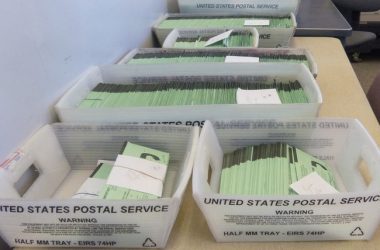
Vale High School teacher Sarah Trask participates in a Zoom meeting in May in her classroom. Trask said the distancing learning model adopted by the school district in response to the Covid pandemic was challenging for students and instructors. (The Enterprise/Pat Caldwell).
VALE – Vale High School teacher Sarah Trask doesn’t hesitate when asked what the most important lesson she learned was when the district switched to a distance learning model in March.
“Be flexible. Because you can have the best plans and three minutes in, you must make a change because someone’s internet – or my internet – goes down,” said Trask.
Trask has taught across a wide spectrum in her 22-year teaching career. She worked as an instructor for history, math, business and was an assistant principal in the Vale School District for a year. During the 2019-2020 year, Trask taught math and business and technology.
Nothing, though, prepared her for the abrupt switch by the Oregon Department of Education to distance learning in March in response to Covid. Teachers across Malheur County had to adapt quickly and interviews with those considered successful at doing so showed adaptability was key.
That doesn’t mean they weren’t surprised.
“I was just somewhat dumbfounded they were just going to completely shut it down. It was just kind of hard to believe it was going to be that abrupt,” said Trask.
Trask was familiar with distance learning but not as a teaching model.
She had just obtained a Prometheus Board, an interactive whiteboard that allows instructors to project an image from a laptop, to replace her smartboard. So she went online to research what she could do with that.
Trask said she adjusted and adapted technology to meet the varying needs of her students.
“For pre-calculus, I recorded a bunch of videos and used Prometheus to annotate my notes as I went along, and the kids kind of worked at their own pace,” she said.
One of her other duties before schools closed was supervising the school’s coffee shop, which teaches students how to run a business.
Closure required a different approach because the exodus of students meant no customers for drinks.
“I ended up using a textbook on some of the culinary programs. Food safety went along with that well. At the end, we also did some market research on different coffee shops in the area to see how our prices compared,” said Trask.
The key, she said, was “tailoring each class, the method of delivery, to what was needed for that group.”
Student access to technology – such as computers – and the internet was a concern, said Trask.
“I knew a lot of kids were not going to have issues, but I think we ended up with 20 to 30% had serious lack of technology and internet access from home. So, it was trying to figure out what kids had technology,” said Trask.
Trask said the ability of the district to provide Chromebooks was critical.
One impact Trask didn’t expect was the lack of face-to-face interaction with students.
“Missing the kids – it is a big challenge when you are used to them. And we were sitting a lot more. As teachers, you’re usually up and about,” said Trask.
Trask addressed those issues by using Zoom more and working from her classroom instead of from home – “just to have that routine.”
The start of the distance learning phase for Trask was packed with uncertainty because of the diversity of subjects she taught.
“For my math class I needed to make sure they had access at home to a computer so they could do the secure online testing I needed to have them do. So, I ended up doing a lot of phone calls initially,” said Trask.
After that, she used online methods.
“They ended up finding different programs that worked best for them and submitted work through either Google classroom or email,” said Trask.
Trask cautioned her students that distance learning would not “going be the same as what we could do in class together.”
“It would be much slower, and I didn’t want them to worry about how they were going to do in class,” she said.
Trask said one advantage for her students and the district was the timing of the change to distance learning.
“I felt we were lucky that if it had to happen, it happened at the end of the year because I knew most of what we needed to cover we’d already covered,” said Trask.
,Trask said student participation stayed steady until the end of the term.
“About 95% of my kids participated throughout,” said Trask.
For Trask, agility was crucial.
“You end up making the best decisions at every moment as every little new challenge comes up. Those first few weeks were incredibly challenging because we would be going along thinking we knew the road we were on, and then we’d get new mandates from the state,” she said.
News tip? Contact Pat Caldwell at [email protected].
KEEP THE ENTERPRISE GOING AS OTHERS CLOSE…..
Reader support allows the Enterprise to provide in-depth, accurate reporting that otherwise would not get done. Keeping the community well informed is essential. SUBSCRIBE – $5 a month, automatically. DONATE – to provide additional support.




